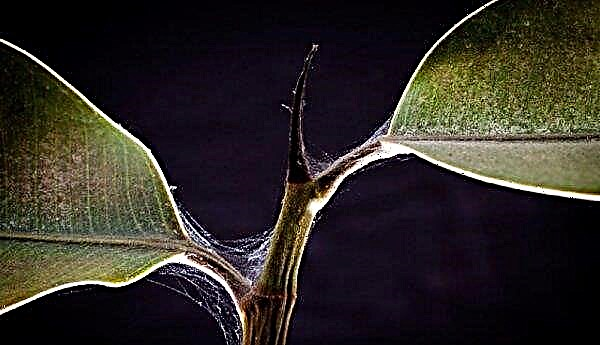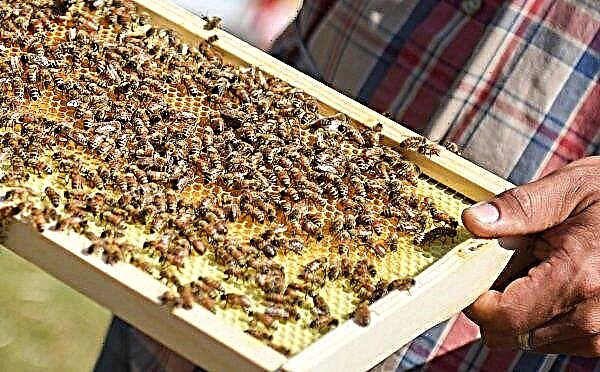Ears in rabbits are much more important than is commonly believed - according to their condition, various diseases can be diagnosed. These organs themselves are prone to certain diseases, which a person who is involved in the maintenance and breeding of such animals should know about. Knowledge will help to take therapeutic measures, protect the livestock and even save it from death.
Diseases and parasites
It is not easy to independently diagnose rabbit ear diseases, despite the fact that their list is small. This is due to the fact that the symptoms are similar, especially in the early stages. Waiting for the manifestation of obvious signs is often dangerous - the animal may die without assistance or infect others. If you see that the rabbit often itches, rubs its ears on the cage, shakes its head, behaves uneasily, refuses to eat, his ears fall - these are all signs of illness or the presence of parasites. Do not delay inspection and take action immediately.
If you see that the rabbit often itches, rubs its ears on the cage, shakes its head, behaves uneasily, refuses to eat, his ears fall - these are all signs of illness or the presence of parasites. Do not delay inspection and take action immediately.
Did you know? Rabbits can simultaneously carry two offspring from different males and with different times of conception. This phenomenon is due to the bifurcated uterus of females and has become the cause of the famous fecundity of these animals.
Ear scabies
The disease is caused by rounded mites up to 1 mm in size, which affect the auditory canals of animals. The neglected stage is dangerous by complication, infections, pus formation. The liquid drains into the ear and forms a plug in it - ultimately this leads to meningitis and the death of the pet.
Symptoms of ear scabies:
- restless behavior, head shaking;
- attempts to scratch ears with paws;
- the rabbit rubs his head, ears on the bars and walls of the cage;
- redness of the shell with small red tubercles;
- if the disease is not detected immediately, the tubercles turn into vesicles with a clear liquid;
- bubbles burst, leaked fluid dries and forms crusts;
- appetite decreases, the rabbit is lethargic;
- ears hang, wool falls out at their base.
 The patient must be isolated in a separate cell. The inventory and the cell are disinfected with 2% chlorophos or 0.5% butox. For treatment, birch tar, sulfuric ointment or Yam ointment, rubbing with 1% chlorophos or ASD-3 are used. The entire inner surface of the ears and ear canal is processed. Replaceable things that the patient used must be burned.
The patient must be isolated in a separate cell. The inventory and the cell are disinfected with 2% chlorophos or 0.5% butox. For treatment, birch tar, sulfuric ointment or Yam ointment, rubbing with 1% chlorophos or ASD-3 are used. The entire inner surface of the ears and ear canal is processed. Replaceable things that the patient used must be burned.Ear mite
Another name for the disease is psoroptosis. An oval mite about 0.6 mm in size settles in the rabbit ears, as there are many blood vessels in them. If you have a magnifying glass at home, you can check for the presence of a tick by taking a scraping from the ear canal and placing it in Vaseline oil, heated to 40 ° C. It is transmitted from one individual to another and, if untreated, can cause inflammation of the brain.
Recommended Reading

Symptoms of parasite infection:
- the rabbit rubs his ears on hard surfaces;
- frequent combing paws;
- small wounds with a sacrum;
- dried scabs;
- accumulation of sulfur in the ears.
Myxomatosis
A dangerous disease with a fatal outcome, which is carried by blood-sucking insects (fleas, mosquitoes, bugs). The causative agent of myxomatosis is a virus, therefore, it can not be treated with alternative methods, only medications will help here. The incubation period is from 7 to 18 days.
External manifestations of the disease:
- subcutaneous tumors - bumps on the rabbit's ears, on the head, next to the genitals and anus;
- folds on the head of the animal;
- inflammation of the mucous membranes of the eyes;
- purulent expiration and adhesion of the eyelids;
- hanging ears;
- there may be swelling around the tumors or small abscesses that open and fester.
 For accurate diagnosis, a veterinary examination is necessary. If myxomatosis is edematous, it makes no sense to treat it, the beast is killed and disposed of (burned), the cells are disinfected. Eating such meat is neither human nor animal.
For accurate diagnosis, a veterinary examination is necessary. If myxomatosis is edematous, it makes no sense to treat it, the beast is killed and disposed of (burned), the cells are disinfected. Eating such meat is neither human nor animal.For the treatment of nodular myxomatosis (abscesses with pus), local antiviral drugs are used, the cones are lubricated with iodine. Every day, once before recovery, subcutaneous injections should be given - 0.2 ml of Gamavit and 1 ml of Fosprenil. Vitamin B injections will benefit the immune system. Give Baytril to drink for 7 days, diluting 1 ml per 10 kg of rabbit in water. For the eyes, drops or Ofloxacin ointment are needed, Aquamaris is dripped into the nose.
Important! If rabbits have confirmed myxomatosis, your veterinarian or you yourself must notify your local veterinary service. This is an epidemiological virus and requires two weeks of quarantine.
Purulent otitis media
Otitis is an inflammation caused by various bacteria (less commonly fungi) that settle behind the eardrum. The inflammatory process leads to the formation of fluid, and later pus. If nothing is done, the membrane can collapse, the infection will spread throughout the ear, which will end in death.

Symptoms of otitis media in rabbits:
- the animal scratches the ears and shakes them;
- the head is constantly tilted;
- discharge from the ears and an unpleasant odor;
- the animal stumbles upon objects, falls, spins in place.
Treatment should be prescribed by a veterinarian; antibiotics are used here, for example, bicillin or chloramphenicol. These drugs are good in treating purulent otitis media of the inner and middle rabbit ear. For the internal, you can also use the antibiotic ciprofloxacin. The duration of treatment is up to 6 weeks with continuous medical intervention.
Disease Symptoms
There are many causes of diseases in rabbits: these are not only viruses and parasites, but also non-compliance with the temperature regime, poor nutrition, unsanitary conditions in the cells, and increased dampness. Regularly monitor the condition of the animals in order to provide assistance in time if necessary. And for this, you need to understand the symptoms.
Ear bleeding
There are many vessels in the rabbit ear, as mentioned above, so even a small scratch can lead to bleeding. Injuries are the most common cause of bleeding. An individual can scratch its ear with its claws, catch on a nail or net, be damaged on twigs or hardened, dry hay.
If the damage is mechanical and there are no more signs of the disease, treat the wound with hydrogen peroxide. Then you need to stop the blood, cauterizing the wound with 70% alcohol. Wound disinfection will protect the rabbit from infection, inflammation and rotting of tissues. If necessary, any antiseptic ointment is applied.
Abalone drop
There are many reasons for the fall of ears in rabbits:
- parasites in the body;
- neglected otitis media;
- myxomatosis;
- mechanical trauma;
- foreign object in the ear canal.
 The erect ears of a rabbit can sometimes be lowered for a short while without any disease. In any case, inspect it for ulcers, lumps, discharge from the ears, monitor appetite and behavior. If an external body has entered the channel, it can be carefully pulled out with tweezers.
The erect ears of a rabbit can sometimes be lowered for a short while without any disease. In any case, inspect it for ulcers, lumps, discharge from the ears, monitor appetite and behavior. If an external body has entered the channel, it can be carefully pulled out with tweezers.Earwax buildup
Rabbit care includes periodic ear cleaning. Otherwise, sulfur clogs the auditory canal, causing infections and diseases. The rapid accumulation of sulfur may indicate malnutrition in animals.
To clean your ears you will need hydrogen peroxide and a cotton swab to soak in it. Gently and slowly wipe the inside of the ear and repeat the procedure twice a day until thoroughly cleaned.
Important! Peroxide dries the skin and can cause microcracks. To avoid this, wipe the rabbit’s ear with olive or vegetable oil after the procedure.
Cones on the ears
Dense formations on the ears in the form of tumors or cones in most cases indicate myxomatosis. In this case, the cones appear throughout the body of the animal, the appetite decreases or disappears completely. If nothing is done, the individual will die within 10 days. For an accurate diagnosis, and to avoid the spread of the virus, call your veterinarian immediately.
For an accurate diagnosis, and to avoid the spread of the virus, call your veterinarian immediately.
Sores in the ears
Regardless of the cause of the appearance of wounds, they need to be wiped with 3% hydrogen peroxide. When they dry, apply streptocid ointment to the wounds and make the dressing a sterile bandage. Try not to tie the bandage tight. Repeat the procedure once a day until complete healing. If the wounds are not mechanical and are accompanied by other symptoms - for example, inappropriate behavior of the rabbit (shakes his head, falls, is inactive, itches intensively), most likely we are talking about an ear mite or otitis media.
If the wounds are not mechanical and are accompanied by other symptoms - for example, inappropriate behavior of the rabbit (shakes his head, falls, is inactive, itches intensively), most likely we are talking about an ear mite or otitis media.
Red spots
The appearance of red spots is a sign of a fur tick or the first stages of myxomatosis. In both cases, you will need to show the animal to the doctor.
Red spots on the ears may indicate annular worms under the skin (microsporia). It is easy to remove parasites by lubricating the ears with Fungin, but do not use ointments from a human pharmacy - if it gets into the rabbit's mouth, the outcome may be worse than microsporia.
Did you know? Rabbits see everything that happens behind them, without even turning their heads. They got this feature due to their natural eye structure.
Acne
Another likely symptom of myxomatosis. If there are no other signs of this disease, acne on rabbit ears can talk about food or other allergies. Try changing your diet and giving 1/8 Suprastin tablets twice a day. This anti-allergic drug is sold in a human pharmacy.
Ears hurt and shakes his head
Shaking the head may indicate that the rabbit's ears are sore, itchy, or a foreign body has got inside. An individual can rub its head against a wall or floor of the cage, shake its head often, and try to scratch its ears with its paw. Inspect them for wounds, redness, seals, pus. Depending on the accompanying signs, the animal may be suffering from scabies, otitis media, or the same myxomatosis.
Ear plaques
The presence of plaques indicates a scabies mite; they appear when the form is running. The color of the scab shows the depth of penetration of the disease - the darker the worse the situation. If plaques appear on the body, on the feet - immediately call a veterinarian, medical treatment will be required.
Pus in the ears
Examine the rabbit for a source of pus. It may be:
- undetected mechanical damage to which the infection has got;
- purulent otitis media;
- nodular myxomatosis;
- advanced stage of the ear tick.
Diseases caused by temperature
Not only viruses and parasites can cause ear disease in rabbits. These are quite whimsical animals, therefore it is important to observe the correct temperature regime so that they do not suffer from overheating or hypothermia.
Overheat
Rabbits fight overheating by shedding excess heat through their ears. If the heat is too high, the animal's body cannot cope with it and the pet receives heat stroke.
Symptoms of overheating:
- the animal is looking for the most shaded and cool place;
- apathy, real estate;
- accelerated, jerky breathing;
- transition to deep breathing with an increase in body temperature over 40 ° C;
- convulsions.
 Overheating leads to the death of the rabbit if nothing is done. Having noticed the first symptoms, transfer it to the shade and put a cool, moist compress on its paws and head. Wet the fabric every 5 minutes. Water temperature 15–18 ° С.
Overheating leads to the death of the rabbit if nothing is done. Having noticed the first symptoms, transfer it to the shade and put a cool, moist compress on its paws and head. Wet the fabric every 5 minutes. Water temperature 15–18 ° С.Hypothermia
Paws and ears are the first to suffer from low temperature.
- The first degree of frostbite is a swelling on the skin, when you touch the rabbit it hurts.
- The second stage is bursting blisters, in the place of which ulcers form.
- The third stage is the death of tissues.
Important! The maximum allowable temperature for rabbits is 25 ° C. Overheat going fast in animals already at 35 ° C.
All symptoms are visible to the naked eye. Having noticed hypothermia, take the individual to a warm room and grease the affected ears with pork or goose fat. Instead of fat, you can use camphor ointment or petroleum jelly.
In the second stage of the wound, you need to lubricate with iodine or camphor ointment. On the third - you can’t do without the help of a veterinarian, since dead tissue will have to be removed, and it is important to do this correctly.
Disease prevention
Preventive measures for keeping rabbits should be strictly followed. The treatment of ear diseases is often lengthy and costly and inconvenience to both you and the animals. To avoid this, follow simple rules:
- vaccination of rabbits from myxomatosis at the age of 45 days (pregnant rabbits can be vaccinated);
- regular inspection of individuals;
- cleaning ears from dirt and sulfur;
- disinfection of feeders, drinking bowls, litter, cells at least once a month;
- warming the cells with straw and transferring them to a warming room in the cold season;
- placing cells in the shade and in a ventilated place in the warm season;
- 2 weeks quarantine for newly purchased rabbits;
- diet of high-quality and wholesome food;
- regular cleaning of cells - they must be clean and dry.
 Due to ear diseases that owners ignore, animals often die, endangering the entire population of rabbits. Timely measures taken and disease prevention minimize the risk of death or eliminate it altogether.
Due to ear diseases that owners ignore, animals often die, endangering the entire population of rabbits. Timely measures taken and disease prevention minimize the risk of death or eliminate it altogether.












